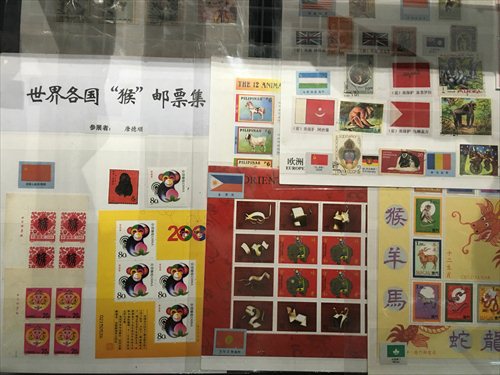
Items on show at the Spring Festival customs exhibition in Shanghai Mass Art Center (Photo: Qi Xijia/GT and courtesy of the venue)
A Spring Festival customs exhibition currently on display in Shanghai charts some of the ways the Chinese New Year has been celebrated.
The exhibits, which come from private collections in Shanghai, show personal stories related to the Spring Festival.
Monkey stamp
The 83-year-old Tang Deshun (pictured below) is showcasing his collection of monkey stamps, including the first monkey zodiac stamp released in 1980, which was also a Monkey year. Tang has been collecting stamps for more than half a century.
"I have been collecting since 1955 when I graduated from university. I thought collecting stamps was a good, cultivated hobby," Tang told the Global Times.
He continues to collect stamps to this day. "I pay in advance to get a new stamp every year."
The nicely dressed old man with white hair was beaming with joy when he introduced his collection to others.
"The monkey zodiac stamp is among the first zodiac stamps released in China. Thus it has a huge value among stamp collectors," Tang said.
The stamp (below) features a black, fat, fluffy monkey seated against a red, festive background. The monkey's round eyes gaze hopefully into the distance. The year and value of the stamp is printed in the bottom right corner.
A large number of the stamps were issued, but as the years passed, the number surviving has decreased.
While Tang bought it for 8 cents, the value of the stamp has soared to 10,000 yuan ($1,519).
Tang also showed the Global Times an envelope with a used monkey zodiac stamp on it, which he said has a market value of 3,000 yuan.
Tang said he has collected four rounds of monkey zodiac stamps, released respectively in 1980, 1992, 2004 and 2016.
Also on show are about 150 monkey stamps from 60 other countries, including Japan, the U.S. and Canada.
"Since 2000, many Asian countries also started to release monkey zodiac stamps. I am showcasing monkey stamps to let others know that monkey stamps not only exist in China but also many other countries," said Tang.
Red envelopes
Zhang Wenxiang is showing his collection of red envelopes at the exhibition. It features 24 red envelops ranging from the late Qing Dynasty (1644-1911) to the 21st century.
The biggest one is from the late Qing Dynasty, at almost three times the size of the red envelopes most commonly used these days.
Zhang told the Global Times that, rather than being used for money, the envelope would have contained a list of gifts.
During the Republic of China (1912-49) era, the red envelopes became the size of those we are accustomed to today.
They featured many festival patterns such as dragons, phoenix, children and flowers. The patterns were first carved on a wood block then printed on to the red paper.
Zhang has been collecting red envelopes for decades. "I think the red envelopes are nice. Each year there are different patterns. I am fascinated by the culture behind them," said Zhang.
Changing value
Zhang said that when he started collecting red envelopes, they would cost 1 yuan. Now the price has soared to 100 yuan.
Now a grandfather, Zhang can still recall the excitement when he received red envelopes from his parents.
"When I was a kid, my parents couldn't afford red envelopes, so they would wrap the money in a red cloth and some paper and stuff it into my newly made clothes. There was not much money in the red envelope. But it represented their best wishes to me for the new year," said Zhang.
"In the past it was not easy to save money. Kids took it seriously when they received the red envelope from their parents. Nowadays, kids seem to take it for granted and keep demanding more," he added.
"I am very happy to share my collection with others in this exhibition. I think collections should not be kept to oneself but shared with others. I have got to know many new friends who are interested in red envelopes."
Sun Jun from Shanghai Mass Art Center where the exhibition is being held told the Global Times that there will continue to be a series of events at the venue during the Spring Festival, including a traditional Chinese opera saloon and talks on customs.
On the day of the Lantern Festival there will be blind dates for young people, a tea ceremony performance, as well as presentations on Chinese culture.
"We wish not only to show Spring Festival customs, but also invite more young people to engage in these events so as to pass these customs down," Wu Rongmei from Shanghai Mass Art Center said.


















































